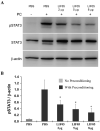Preconditioning-induced protection from oxidative injury is mediated by leukemia inhibitory factor receptor (LIFR) and its ligands in the retina
- PMID: 19344761
- PMCID: PMC2683190
- DOI: 10.1016/j.nbd.2009.03.012
Preconditioning-induced protection from oxidative injury is mediated by leukemia inhibitory factor receptor (LIFR) and its ligands in the retina
Abstract
Preconditioning with moderate oxidative stress (e.g., moderate bright light or mild hypoxia) can induce changes in retinal tissue that protect photoreceptors from a subsequent dose of lethal oxidative stress. The mechanism underlying this induced protection is likely a general mechanism of endogenous protection which has been demonstrated in heart and brain using ischemia and reperfusion. While multiple factors like bFGF, CNTF, LIF and BDNF have been hypothesized to play a role in preconditioning-induced endogenous neuroprotection, it has not yet been demonstrated which factors or receptors are playing an essential role. Using quantitative PCR techniques we provide evidence that in the retina, LIFR activating cytokines leukemia inhibitory factor (LIF), cardiotrophin-1 (CT-1) and cardiotrophin like cytokine (CLC) are strongly upregulated in response to preconditioning with bright cyclic light leading to robust activation of signal transducer and activator of transcription-3 (STAT3) in a time-dependent manner. Further, we found that blocking LIFR activation during preconditioning using a LIFR antagonist (LIF05) attenuated the induced STAT3 activation and also resulted in reduced preconditioning-induced protection of the retinal photoreceptors. These data demonstrate that LIFR and its ligands play an essential role in endogenous neuroprotective mechanisms triggered by preconditioning-induced stress.
Figures








References
-
- Bird AC. Retinal photoreceptor dystrophies LI. Edward Jackson Memorial Lecture. Am. J. Ophthalmol. 1995;119:543–562. - PubMed
-
- Cao W, Li F, Steinberg RH, Lavail MM. Development of normal and injury-induced gene expression of aFGF, bFGF, CNTF, BDNF, GFAP and IGF-I in the rat retina. Exp. Eye Res. 2001;72:591–604. - PubMed
-
- Cao W, Wen R, Li F, Lavail MM, Steinberg RH. Mechanical injury increases bFGF and CNTF mRNA expression in the mouse retina. Exp. Eye Res. 1997;65:241–248. - PubMed
-
- Chaum E. Retinal neuroprotection by growth factors: a mechanistic perspective. J. Cell Biochem. 2003;88:57–75. - PubMed
Publication types
MeSH terms
Substances
Grants and funding
LinkOut - more resources
Full Text Sources
Miscellaneous

